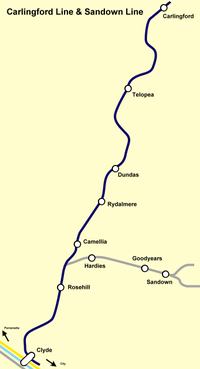Sandown railway line
| Sandown Line | |||
|---|---|---|---|
| Overview | |||
| Status | Closed | ||
| Locale | Sydney | ||
| Stations | 4 | ||
| Operation | |||
| Opened | November 1888 | ||
| Closed | 2010 | ||
| Owner | RailCorp | ||
| |||
| Sandown Line | |||||||||||||||||||||||||
|---|---|---|---|---|---|---|---|---|---|---|---|---|---|---|---|---|---|---|---|---|---|---|---|---|---|
| |||||||||||||||||||||||||
The Sandown Line is a short former industrial railway line in the western suburbs of Sydney, New South Wales, Australia. It began life as the Bennett's Railway, opening on 17 November 1888.[1] The line branched from the Carlingford line at Camellia Junction, just north of Rosehill station. It was electrified in 1959.
In its final years the railway was used by occasional freight trains only, usually carrying empty containers to and from storage at Sandown; but, when electrified, it carried an infrequent electric suburban service to serve the surrounding industrial area, operated by single-deck 3-car trains (marshalled as Y-sets). The line had three simple stations: Sandown, Hardies and Goodyear (a platform called Cream of Tartar Works closed prior to electrification). The closure of Goodyear station preceded the closure of the remaining two. All stations were unattended by staff members.
The overhead wires were removed in December 2002. Traffic was officially suspended and a Stop Block placed across the tracks on the Sydney side of Access Rd level crossing in October 2016.
The western end of the line will be used by the Parramatta Light Rail project to provide access to a tram stabling and maintenance facility.[2] This will see the line officially closed. The section of the Carlingford line from where the Sandown line diverges to the Parramatta Road level crossing will also be closed.[3]
See also
References
- ↑ Singleton, C.C. (May–June 1955). "Railways and Tramways of the Parramatta Hills District - Clyde to Carlingford and Sandown Railways". Australian Railway Historical Society Bulletin. pp. 50–54/57–62.
- ↑ "Preferred route - stage 1" (PDF). Transport for NSW. Retrieved 17 February 2017.
- ↑ "Parramatta Light Rail | Stage 1 – Westmead to Carlingford via Camellia: Environmental Impact Statement" (PDF). Transport for NSW. pp. 5–65, 5–66. Retrieved 24 August 2017.
External links
